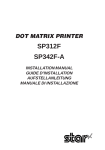Download Star Micronics TUP492-24 User's Manual
Transcript
THERMAL UNIT PRINTER MECHANISM TUP492-24 SPECIFICATION AND OPERATION MANUAL NOTICE • All rights reserved. Reproduction of any part of this manual in any form whatsoever, without STAR’s express permission is forbidden. • The contents of this manual are subject to change without notice. • All efforts have been made to ensure the accuracy of the contents of this manual at the time of going to press. However, should any errors be detected, STAR would greatly appreciate being informed of them. • The above notwithstanding, STAR can assume no responsibility for any errors in this manual. Copyright 1998 Star Micronics Co., LTD. –0– CONTENTS 1. GENERAL DESCRIPTION ..........................................................................................................1 2. CONSTRUCTION ..........................................................................................................................2 2.1 Configuration .......................................................................................................................2 2.2 Principle of Operation ..........................................................................................................2 3. GENERAL SPECIFICATIONS ....................................................................................................4 4. PAPER ROLL SPECIFICATIONS ..............................................................................................5 5. PRINTER SETTINGS ....................................................................................................................7 5.1 Switches and Buttons ...........................................................................................................7 5.2 Setting the DIP Switches......................................................................................................8 5.3 Setting the EEPROM .........................................................................................................10 6. DISPLAYS AND FUNCTIONS ...................................................................................................12 6.1 LEDs ..................................................................................................................................12 6.2 RESUME Button................................................................................................................12 6.3 Power Switch and Button Combinations ...........................................................................12 6.4 Sensor Adjusting Mode......................................................................................................13 6.5 Near-End Sensor ................................................................................................................13 6.6 Error Messages...................................................................................................................14 6.7 Near-End Sensor Position ..................................................................................................16 7. INTERFACE .................................................................................................................................17 7.1 Serial Interface (RS-232C or RS-422A) ............................................................................17 7.2 Parallel Interface ...............................................................................................................19 8. CUTTER .......................................................................................................................................20 9. PRESENTER .................................................................................................................................21 10. CHARACTERS .............................................................................................................................22 10.1 Character Set ......................................................................................................................22 10.2 Characters and Sizes...........................................................................................................22 11. POWER REQUIREMENTS ........................................................................................................23 12. NOISE.............................................................................................................................................25 13. STANDARDS.................................................................................................................................25 14. RELIABILITY ..............................................................................................................................26 14.1 During operation ................................................................................................................26 14.2 During storage ....................................................................................................................26 14.3 Allowable Static Electricity Level ....................................................................................27 14.4 Vibration Test.....................................................................................................................27 14.5 Drop Test ...........................................................................................................................27 14.6 Life Test .............................................................................................................................28 15. INSTALLING THE PAPER ROLL............................................................................................29 16. INSTALLATION ..........................................................................................................................31 16.1 Installation precautions ......................................................................................................32 16.2 Other precautions ...............................................................................................................32 17. MAINTENANCE ..........................................................................................................................36 1. GENERAL DESCRIPT The TUP492-24 printer is a line thermal printer and is used in various electronic equipment, such as game machines, ATMs and information kiosks. TUP492-24 is equipped with a presenter which discharge and collect paper. These printers feature the following: 1. High-speed printing: 2 in./sec (50 mm/sec) 2. High resolution: 8 dots/mm vertically, 8 dots/mm horizontally (approx. 200 dpi) 3. Silent operation 4. Paper roll size: max. 8-inch diameter 5. Choice of three types of interfaces (optional) 6. Presenter function Display of Model Name TUP4 9 2 D — 24 NL Equipped with no translucent sensor Power supply voltage : DC 24 V Interface D: RS-232C C: Parallel K: RS-422A Mechanism type 2: 40 digits Printer type 9: Equipped with a guillotine-type full cutter and presenter (discharge and collect) TUP400 series thermal printer –1– 2. CONSTRUCTION 2.1 Configuration The unit printer mechanism is constructed of the following components: Unit printer mechanism Thermal printer Sensor Thermal head Drive Gear Platen Presenter Motor Cutter (guillotine-type full cutter) Frame Control and interface boards Near-end sensor 2.2 Principle of Operation 2.2.1 Drive and paper feed The rotation of the stepping motor is transmitted to the gear, which turns the platen. The rotation of the platen generates friction between it, the thermal paper and the thermal head, therefore causing the paper to be fed. 2.2.2 Printer Color appears on the thermal paper as the temperature of the thermal head’s heat-generating element increases. 2.2.3 Presenter The edge of the thermal paper stops just before the presenter’s ejector, the continuous feed of the thermal paper creates a loop and after printing is finished, the paper is cut. Then, the paper is fed out by the roller in front of the ejector (The DC motor rotates the roller). Detecting the paper bottom end, the roller stops its rotation. When the fixed period of time passes, or the collection command is sent, the presenter collects the paper. –2– Exterior View Arm Inter face Paper guide Head stay Thermal mechanism Presenter B A Frame (Inside is the main PCB and interface PCB) –3– 3. GENERAL SPECIFICATIONS Item Specification Printing method Line thermal direct printing Printing speed 50 mm/sec, 25 mm/sec Printing area 80 mm wide (page mode), 75 mm wide (line mode) Resolution 8 dot/mm (horizontal) 8 dot/mm (vertical) Paper width 82.55 mm (3.25 in.) Paper roll diameter Outer: max. 203 -20 mm (approx. 8 in.) Inner: 32 +10 mm (approx. 1.26 in.) Characters ASCII International character set Katakana (Japanese syllabary) Bar code Paper detection Paper-out detection using a reflecting photo sensor Black mark detection using a reflecting photo sensor Paper near-end detection using a reflecting photo sensor Interface Serial (RS-232C or RS-422A (optional)) Parallel Data buffer Approx. 8 KB Auto cutter Guillotine-type full cutter Power supply voltage DC 24 V ± 7% Environment Temperature 5˚C to 40˚C Relative humidity 25% to 80% (no condensation) External dimensions 173 mm (W) × 355 mm (D) × 175 mm (H) (without paper roll inserted) 173 mm (W) × 382 mm (D) × 254 mm (H) (with 8-in. paper roll inserted) Weight Approx. 3.45 kg –4– 4. PAPER ROLL SPECIFICATIONS Item Specification Paper type Normal heat-sensitive paper Paper width 82.55 –10 mm (3.25 in.) Paper thickness 60 to 100 µm Core diameter Inner: 32 +10 mm Outer: 35 +10 mm Paper type Nippon Seishi TF50KS-E TF62KS-E KF-730 Shin Oji Seishi Printing area 82.55 mm 275 mm 80 mm Printing area 82.55 mm 3.775 mm 75 mm Printing area (Page mode) Black mark Printing density Printing position (Line mode) Macbeth valve 1.2 or higher 26 mm Paper feed Max. 36 mm Printing side Size Back (opposite to the printed side) Width: 10 to 20 mm (center of the paper must be avoided) Length: 3 to 10 mm Reference position The end of the black mark should be positioned at the front in the paper feed direction. –5– Notes) ● Use paper that is rolled inward. ● Do not affix the end of the paper to the paper roller. ● Paper jams may occur depending on the paper quality used and the pattern printed. ● If the machine is turned off and left for a long time with paper caught in the thermal head, the paper should be removed and inserted again. ● Keep this machine on a level surface. ● The roller may leave short marks in the end of the paper. –6– 5. PRINTER SETTINGS 5.1 Switches and Buttons The DIP switches and memory switches (EEPROM) are used to make the printer’s settings. In addition, the sensor adjusting button and RESUME button, which are not used for making printer settings, are installed. The sensor adjusting button is located on the paper-out and near-end sensor’s PCB (N.EPCB), and is mainly used for adjusting the photo sensors, therefore, it is not used by the general user. The RESUME button is located on the casing (near the LF motor), and is used to bring the printer back on line after it goes off line (e.g. paper-out). For more details about the RESUME button, refer to “6. DISPLAYS AND FUNCTIONS”. The DIP switches are mounted to the interface’s PCB and can be changed by operating them from the hole used for replacing the EPROM or by removing the interface’s PCB. The number of DIP switches differs according to the type of interface. Centronics: RS-232C: RS-422A: None 1 (8-bit) 2 (8-bit and 4-bit) The EEPROM is 1 word by 16 bits. The EEPROM is mounted on the main unit’s PCB and can be changed with the commands. –7– 5.2 Setting the DIP Switches All of the DIP switches have been set to ON at the time of shipping. 5.2.1 Serial Interface a) DIP switch 1 (for both RS-232C and RS-422A) Switch position 1-1 1-2 1-3 1-4 1-5 1-6 1-7 1-8 Function ON OFF Baud rate Handshaking Data length Parity Parity DC1, 3 (*1) Power on (*2) DTR 8 bits Disabled Odd Disabled XON/XOFF 7 bits Enabled Even Enabled *1 Only for the RS-232C (This setting is made with DIP switch 2 on the RS-422A.) *2 For the power on function When DC1, 3 is disabled When DC1, 3 is enabled When addressable Baud rate 1-1 1-2 2400BPS 4800BPS 9600BPS 19200BPS OFF OFF ON ON OFF ON ON OFF 1-8 ON 1-8 OFF Select Select Deselect Select Deselect Select –8– b) DIP switch 2 (only for the RS-422A) SW 2-1 DC1, 3 disabled Address #1 #2 #3 #4 #5 #6 #7 #8 #9 #10 #11 #12 #13 #14 DC1, 3 mode ON OFF ON OFF ON OFF ON OFF ON OFF ON OFF ON OFF ON OFF SW 2-2 ON ON OFF OFF ON ON OFF OFF ON ON OFF OFF ON ON OFF OFF SW 2-3 ON ON ON ON OFF OFF OFF OFF ON ON ON ON OFF OFF OFF OFF SW 2-4 ON ON ON ON ON ON ON ON OFF OFF OFF OFF OFF OFF OFF OFF 5.2.2 Parallel Interface Switch position 1-1 1-2 1-3 1-4 Function ON OFF Mode Not used Not used Mode Compatibility mode Nibble mode (without negotiation, without termination) Byte mode (without negotiation, without termination) Not used –9– 1-1 1-2 ON OFF ON OFF ON ON OFF OFF 5.3 Setting the EEPROM The following command from the host computer is used to make the EEPROM settings. a) EEPROM settings command <ESC> #N, n1 n2 n3 n4 <LF> <NUL> N: Memory switch no. n1 n2 n3 n4: Setting data For more details, refer to “Programmer’s Manual”. b) Memory switch 0 N=0 n1: Always 0 n2: Always 0 n3: Always 0 n4: Mode select 0 1 Page mode (Default) Line mode c) Memory switch 1 N=1 n1: Sensor select n2: Start-position detect n3: Zero style n4: International character set Parameter Setting n1 Sensor select n2 n3 n4 Start-position detect Zero style International character set n4 Country 0 1 2 3 4 5 6 USA France Germany UK Denmark #1 Sweden Italy 0 (Default) Reflective sensor (Black mark) OFF Normal zero n4 7 8 9 A B C – 10 – 1 Transmissive sensor ON Slashed zero See below Country Spain #1 Japan Norway Denmark #2 Spain #2 Latin America d) Memory switch 2 N=2 n1: Always 0 n2: Always 1 n3: Always 0 n4: Printing speed 0 1 50 mm/sec. (Default) 25 mm/sec. e) Memory switch 3 N=3 n1: Always 0 n2: Character table 0 1 2 3 Normal (Default) Katakana IBM IBM n3: Print column 0 1 40 column (Default) 50 column n4: 0 1 2 3 <CR> Disabled <CR> Disabled Same as <LF> Same as <LF> Paper feed 4 mm (Default) Paper feed 3 mm (Default) Paper feed 4 mm Paper feed 3 mm f) Memory switch B N=B n1: Always 0 n2: Presenter 0 1 Not installed (TUP452) Installed (TUP482) n3: Always 0 n4: Always 1 – 11 – 6. DISPLAYS AND FUNCTIONS The LEDs and RESUME button are mounted on the NEPCB. 6.1 LEDs LED Function HU PE ERR Lights up when errors occur (For more details, refer to “6.6 Error Messages”.) 6.2 RESUME Button When no paper is inserted, insert more paper, then press this button to automatically feed the specified length of paper (approx. 80 mm when the presenter is installed or approx. 30 mm when it is not). After the paper is cut, the printer will go back on line. 6.3 Power Switch and Button Combinations The following settings can be made by pressing either the RESUME button or the sensor adjusting button at the same time that the power switch is turned on. <RESUME button and power switch> Buzzer LED One beep HU lights up ↓ Two beeps Function 2 sec. Release the RESUME button to execute a HEX dump. [*1] PE lights up Release the RESUME button to execute a test print. [*2] [*1] The HEX dump mode remains valid until the power is turned off. [*2] The printer continues the test print until the power is turned off. <Sensor adjusting button and power switch> Buzzer LED One beep HU lights up ↓ Function 2 sec. Release the sensor adjusting button to start sensor adjusting mode. [*3] [*3] Do not continue pressing the sensor adjusting button for more than two seconds. Note) The Line and Page modes cannot be chosen with the panel buttons; these modes can only be chosen with commands. – 12 – 6.4 Sensor Adjusting Mode a) Reflecting sensor (black mark sensor) ● Insert the paper in front of the sensor mechanism so that a black mark is not positioned in front of the sensor. ● Adjust the reflecting sensor controller VR4 on the PCB until the HU LED lights up. b) Paper-out sensor ● Insert the paper in front of the sensor mechanism so that a black mark is not positioned in front of the sensor. ● Adjust the paper-out sensor controller VR3 on the PCB until the PE LED lights up. 6.5 Near-End Sensor Selecting the open frame setting with memory switch B enables near-end sensors A and B. It is possible to determine the state of near-end sensors A and B by outputting the <EOT> command to the printer. (This is only possible when a serial interface is used.) Refer to “Programmer’s Manual”. – 13 – 6.6 Error Messages It is possible to determine the type of error occurring by observing the printing results and which LED lights up. a) Recoverable errors The printer goes off line when these errors occur. To resume operation, remove the cause of the error, then press the RESUME button. Error Head up error Paper-out error Label size error Cause LED ERR The head is raised. No paper is inserted. The paper size differs from the measured size. HU PE On On On b) Unrecoverable errors The printer goes off line when these errors occur. Operation of the printer will be resumed by pressing the resume button after the cause of the unrecoverable error is removed. Error Command error Cutting error Transmission error *1 Paper jam error *2 Cause There is an error in the command. The paper is not cut properly. There is an abnormality in the received data. The paper is not fed up to the sensor. LED ERR On On On On HU PE On On On On *1 Valid only with the serial interface *2 If the paper is jamed inside the presenter 1 Paper Jam, Case 1: Removing paper from inside the presenter. (Procedure) 1) If there is a paper jam at the Open/Close plate, lower the Open/Close plate if it is in the up position. (If it is in the down position, leave it down.) 2) Remove the jammed paper from the space below the presenter unit. Note) When lowering the Open/Close plate, be careful not to bend the PET film unit. – 14 – 2 Paper Jam, Case 2: Removing paper from near the cutter. (Procedure) 1) When paper is jammed inside the cutter, if it cannot be removed by the procedure in Case 1, take out the screws on both sides of the presenter, as shown in the figure. 2) Slide the presenter along the * part in the figure, separating the presenter and the cutter, then remove the jammed paper. 3) After removing the jammed paper, slide the presenter back, following the procedure in 2) in reverse order, then fasten it in its original position using the screws. Note) When fitting the presenter with the cutter in 3) above, be careful not to get the two wires shown in the figure caught between the presenter and cutter. c) Other errors ● Data errors (<ESC> “PC” command: defines character and bar code data) A data error will occur if an invalid character or bar code type is selected or if the print result extends outside the print area. When a data error occurs, all commands become invalid (character strings and bar codes are not printed). However, the printer will not go off line and the LEDs will not light up. – 15 – 6.7 Near-End Sensor Position <Technical Specifications> The near-end sensors can be moved a maximum of 5 mm to the right or left by moving the near-end sensor PCB. Slightly loosen the three screws (without removing them) used to install the PCB, then move the PCB to the desired position. After making sure that the PCB fits properly (i.e. it is not loose), tighten the three screws. (Do not break the PCB.) Near-end sensor NEA Near-end sensor NEB Near-end sensor PCB Square hole Side frame Screw Can be moved a maximum of 5 mm to the right and left Slot * The near-end sensors are mounted on the back of the PCB. – 16 – 7. INTERFACE Three interface types are available: parallel, serial RS-232C or serial RS-422A. Any of these interfaces can be used by installing the corresponding PCB. 7.1 Serial Interface (RS-232C or RS-422A) RS-232C Item Specification Data transfer method Asynchronous serial interface Data transfer rate 2400, 4800, 9600, 19200 Start bit: 1 Data bit: 7 or 8 Odd, even or no parity Stop bit: 1 Signal polarity Mark = logic “1” (–3 V to –15 V) Space = logic “0” (+3 V to +15V) Connector Pin Assignment (D-SUB 25 pin) Pin No. Signal Name 1 2 3 4 F-GND TXD RXD RTS 5 CTS 6 7 8 ~ 10 11 N/C S-GND N/C RCH 12 13 14 15 16 17 ~ 19 20 N/C S-GND FAULT Multi-TXD Multi-DTX N/C DTR 21 ~ 25 N/C IN/OUT Function — OUT IN OUT Frame ground Transmit data Receive data Send request signal. There is a space when the printer is ready to receive. There is a space when the host computer is ready to send. However, this signal is not checked by the printer. Not used Signal ground Not used There is a space when the printer is ready to receive. Same as pin 20. Not used Signal ground There is a mark when an error is occurring in the printer. Send data for multi printer Receive data for multi printer Not used Data terminal ready signal. There is a space when the printer is ready to receive. Not used IN OUT OUT OUT IN – 17 – RS-422A Item Specification Data transfer method Asynchronous serial interface Data transfer rate 2400, 4800, 9600, 19200 Start bit: 1 Data bit: 7 or 8 Odd, even or no parity Stop bit: 1 Signal polarity Mark = logic “1” (–) Space = logic “0” (+) Connector Pin Assignment Pin No. Signal Name IN/OUT 1 2~6 7 8 9 10 11 ~ 12 13 14 ~ 16 17 18 19 F-GND N/C S-GND N/C SD (+) SD (–) N/C S-GND N/C RD (+) RD (–) CS (+) 20 ~ 22 23 N/C CS (–) IN 24 RS (+) OUT 25 RS (–) OUT OUT OUT IN IN IN Function Frame ground Not used Signal ground Not used Send data Send data Not used Signal ground Not used Receive data Receive data There is a space when the host computer is ready to send. However, this signal is not checked by the printer. Not used There is a space when the host computer is ready to send. However, this signal is not checked by the printer. Send request signal. There is a space when the printer is ready to receive. Send request signal. There is a space when the printer is ready to receive. – 18 – 7.2 Parallel Interface Item Specification Method Centronics Data transfer rate 1000 to 6000 cps Synchronization method External supply strobe pulse Handshaking By ACK and BUSY signals Logic level TTL-compatible Connector Pin Assignment Pin No. 1 2~9 10 11 12 13 14 ~ 15 16 17 18 19 ~ 30 31 32 33 34 ~ 35 36 Signal Name STROBE IN/OUT Function IN Normally HIGH. Data reading starts after this signal becomes LOW. Data. HIGH for “1”, LOW for “0”. Turned ON when data acquisition is complete. Reception of data is possible when this signal is LOW; reception is not possible when HIGH. Becomes HIGH when no paper is inserted. Becomes HIGH when the printer goes on line. Not used Signal ground Printer frame ground DATA 1 ~ 8 ACK BUSY IN OUT OUT PAPER OUT SELECTED N/C SIGNAL GND CHASSIS GND +5 V TWISTED PAIR RETURN RESET ERROR EXT GND N/C — OUT OUT +5 V for external equipment (50 mA max.) Return signal for various signals IN OUT Initializes the printer when LOW. Becomes LOW when the printer cannot function. Ground terminal for external equipment Not used Always HIGH – 19 – 8. CUTTER Item Specification Method Guillotine-type full cutting Drive method DC motor Installation Attached to the mechanism with screws Supply Thickness of one sheet of paper: 60 to 100 µm Minimum cutting length 25.4 mm (no presenter) 80 mm (equipped with presenter) Life (standard paper) 300,000 times Paper debris must be removed. Error An error occurs if the cutter has not returned to the home position within the specified time. Notes) If the cutter is not located at the home position when an error has occurred, it can be returned to the home position by removing the cause of the error and turning the power off, then on again. The cutter can also be returned to the home position by turning off the power, inserting a screwdriver into the hole on the side of the cutter, then rotating the motor until the cutter is returned to the position which is believed to be the home position. – 20 – 9. PRESENTER Item Specification Possible sheet length Approx. 80 mm (min.) Approx. 300 mm (max.) Operation sequence (viewed from the operator’s side) a. The paper is not ejected during printing. b. The cutter cuts the end of the paper after printing is completed. c. The presenter’s roller rotates for 5 seconds, which causes the sheet to be ejected from the exit. The sheet stops when the end leaves the roller. d. The next printing step starts when the sheet is removed by the operator. e. If the sheet is not removed within 5 seconds, the roll begins to rotate. If the status end request (EOT) is sent from the host computer while the sheet is remains at the exit, the host computer will return to status E5. – 21 – 10. CHARACTERS 10.1 Character Set ASCII Katakana (Japanese syllabary) International character set 10.2 Characters and Sizes (Width and length of 1 dot = 0.125 mm (1/8 mm)) 1. Page mode Character face Small characters Standard characters Bold characters OCR-B Full-size Kanji Print size (length × width) 16 × 8 dots 24 × 16 dots 32 × 24 dots 24 × 16 dots 24 × 24 dots 2. Line mode Character face IBM Block Other ANK Full-size Kanji Half-size Kanji Print size (length × width) 24 × 12 or 32 × 12 dots 24 × 12 dots 24 × 24 dots 24 × 12 dots – 22 – 11. POWER REQUIREMENTS The input voltage shall be DC 24 V ± 7% (rated 2.5 A, less than 6 A/15 sec.). The current used when solid printing is performed is shown below. Block 1 (384 dots) 12A 12A Block 2 (256 dots) 8A T 8A T T T 0.5A 0.5A Cycle 2.5ms Item Specification T (weld time) approx. 550 ms (25˚C, standard density) Max. 800 ms depending on the conditions Current (during solid printing) Peak current: 12 A max. Average current: 6.6 A max. 12 × 0.8 + 8 × 0.8 + 0.5 × (2.5 – 0.8 × 2) 2.5 Item Recommended power supply Specification For 100 or 120 V For 230 V Star Micronics Power Supply Unit SLS-060P-50 (Part number: 87393030) Star Micronics Power Supply Unit SLS060PH-50A (Part number: 87393090) – 23 – UL1007 AWG18 Unit junction connector Power connector 1 2 3 4 1 2 3 4 AMP 1-480425-0 JST. VHR-4N Recommended power – unit junction cable Unit power cable 1: 24V 2: 24V 3: GND 4: GND AMP 1-480426-0 – 24 – 12. NOISE Item Specification Measurement standard = ANSI 1.29 (DIN45, ISO7779) Average sound pressure at 1 m 50 dB or less 13. STANDARDS Safety standards 1. UL (RU) 2. CSA – 25 – 14. RELIABILITY 14.1 During operation Temperature: 5˚ ~ 40˚C Humidity: 25% RH ~ 80% RH (no condensation) Operating temperature and humidity ranges % RELATIVE HUMIDITY 100 90 80 70 60 50 40 30 20 10 -20 -10 0 10 20 30 40 50 60 70 80 °C ENVIRONMENTAL TEMPERATURE Notes) When the environmental temperature is too high, the thermal head temperature sensor is activated and the printer stops operating. 14.2 During storage Temperature: –20˚C ~ 60˚C Humidity: 10% RH ~ 90% RH (no condensation) – 26 – 14.3 Allowable Static Electricity Level Quality control test specifications Direct discharge Element allowable level (self-printing) No fracturing of elements allowed Indirect discharge Element allowable level (self-printing) Checker connection allowable level (continuous printing) ± 8 kV (*1) ± 15 kV ± 15 kV ± 3 kV (*2) Direct discharge error: ≤5% Indirect discharge error: 0% Notes) (*1) ±10 kV test is also performed. (*2) ±5 kV test is also performed. ● Use SLS-060P-50 (Sanken) as the power source. ● The reference data is shown in the table above; this data may differ depending on the installation conditions. 14.4 Vibration Test Item Specification Frequency 7 ~ 100 ~ 7 Hz (sweeping: 2.5 minutes) Amplitude 15.3 ~ 0.07 mm Gravity 1.5 G (constant) Vibration direction and time 1 hour in each direction: X, Y and Z Total of 3 hours Packing As small as possible 14.5 Drop Test Item Specification Drop height 80 cm Drop sequence One corner, three edges and six surfaces Packing As small as possible – 27 – 14.6 Life Test MCBF Item Specification No. of printed lines 5 million lines (excluding the thermal head life) Auto cutter 300,000 cutting operations (One sheet of paper should be less than 85 µm.) Thermal head 5 × 107 pulses or a printing distance of 30 km Notes) ● The thermal head life given above is applicable for cases when standard paper is used. ● Printing continuously at a print ratio of less than 12.5% increases the resistance of the thermal head’s heat-generating element by more than 15% of the initial value. ● Excluding damages caused by dust, foreign objects etc. ● Missing dot ratio maximum of 0.5% over 50 km. – 28 – 15. INSTALLING THE PAPER ROLL OPEN Lever Arm Paper roll • Remove the arm from the frame and install the paper roll. • Make sure that the end of the paper is sharply cut. Cutter’s guide Pass the paper over the damper shaft, pass it under the thermal head, then insert the paper between cutter guides. Double check that the paper is inserted into the cutter by looking into the small wholes on the upper cutter guide. Feed the paper until the end enters the presenter’s roller. – 29 – PRESS Firmly press the areas indicated with crosshatches on the thermal head until the lever is reset. Carefully place the paper roll on the frame, then wind the roll to remove any slack in the paper. (Incorrectly installing the paper roll may bend the frame or cause a paper jam.) M SU RE E Press the RESUME button. – 30 – 16. INSTALLATION Installation procedure Install the printer using four M4 bolts as shown in the illustration below. (Refer to the diagram of the “Installation Hole Dimensions”.) Unit printer Metal base M4 – 31 – 16.1 Installation precautions 1. Install the printer on a level surface. (Consult with a representative when installing the printer at an angle.) 2. Be sure that there is plenty of space around the printer. (Refer to the diagram of the “External Dimensions”.) 3. Since the thermal head is very hot, carefully examine where the printer is installed. (When a fan is used to provide ventilation, be very careful of dust since it can damage the thermal head.) 4. Although this printer is made of plated steel sheets, the ends are not plated. 16.2 Other precautions 1. Correctly insert the paper before printing. 2. Do not use or store this printer in a dusty or oily environment or in a place containing a large amount of iron. 3. Remove any dust, paper particles, etc. using either a soft brush or a cloth dampened in alcohol. 4. Do not apply a strong force to the printer. Otherwise, the frame may bend causing the printer to malfunction. 5. The printer should only be used in the specified environmental conditions (temperature, humidity, etc.) and not subject to sudden environmental changes. When sudden environmental changes occur, the printer should be kept in the new environment for approximately 30 minutes before it is used. 6. Do not use the printer if condensation has formed on it. – 32 – 74 5 6 204 349 146 19 2.8 82.5(PAPER WIDE) 103 148 73.3 164.2 (Unit: mm) External Dimensions – 33 – (Unit: mm) – 34 – +0.03 2-3.7 0 13.7 ±0.1 493 3 ø20 123.8 ±0.15 max 72.4 382 19 12 0˚ 45 ˚ 199 204 253 266 151 159 162 175 80 19 Installation Hole Dimensions Using four M4 bolts, install the printer from the bottom as shown in the illustration below. 115±0.1 View A (rear surface) 4-M4 72.4 16 Front Back 130±0.1 (Unit: mm) – 35 – 17. MAINTENANCE Regular maintenance is very important since minute debris of thermosensible paper sticking to the platen may cause slipping of the paper feeder. Maintenance should be made as follows: Maintenance Timing: Generally, TUP series should be maintained every time after using 8 rolls of 8 inch ø Star Standard Spec paper roll, or 6 month. Maintenance Procedures: 1. Make sure that the power supply is turned off before starting the maintenance procedures. 2. Wipe and rub the platen gently with a dry soft cloth to remove all debris stuck on the platen surface. (Turn the platen around to remove debris from all the surface.) * Take enough care not to touch the gears and the cutter guide when wiping the platen to avoid any bodily injury. * Avoid wiping a same spot of the platen continuously, otherwise it may cause deformation of the platen. * Wash your hands thoroughly before touching the platen. Dry soft cloth Platen Cutter guide – 36 – 3. Remove the dirt from the thermal head using a cotton bud or soft cloth dipped in alcohol. 4. Remove all dirt, dust or paper debris, etc. adhering to the sensors (particularly the reflector type sensors) of the thermal mechanism and the presenter. Note) For the presenter’s paper sensor, take out the screws in the presenter cover on the side as shown in the figure below, remove the cover, then remove the dust from above. Also, after maintenance, return the presenter cover to its original position and fasten it with the screws which were taken out before. Presenter Cover Screw Paper sensor – 37 – HEAD OFFICE ELECTRONIC PRODUCTS DIVISION STAR MICRONICS CO., LTD. 536 Nanatsushinya, Shimizu, Shizuoka, 424-0066 JAPAN Tel : 0543-47-0112 Fax: 0543-48-5271 OVERSEAS SUBSIDIARY COMPANIES STAR MICRONICS AMERICA, INC. 70-D Ethel Road West, Piscataway, NJ 08854 U.S.A. Tel : 732-572-9512 Fax: 732-572-5095 STAR MICRONICS U.K. LTD Star House, Peregrine Business Park, Gomm Road, High Wycombe, Bucks, HP13 7DL, U.K. Tel : 01494-471111 Fax: 01494-473333 Please access the following URL http://www.star-micronics.co.jp/service/sp_sup_e.htm for the lastest revision of the manual. Distributed by Printed in Japan, 80874275










































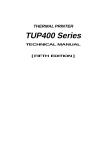
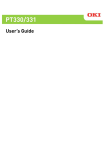
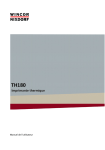


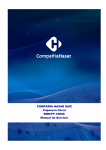
![User's Manual DP8340II SERIES [Parallel]](http://vs1.manualzilla.com/store/data/006876520_1-e14f27ca3e82bd4fbe61e6010073af1e-150x150.png)
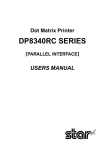
![User`s Manual DP8340II R SERIES [Serial]](http://vs1.manualzilla.com/store/data/005993516_1-f706d7540b19c5fecea062c6335f03cc-150x150.png)
![User's Manual DP8340II SERIES [Serial]](http://vs1.manualzilla.com/store/data/006863352_1-7c329c58d43827994f443f796586090a-150x150.png)
